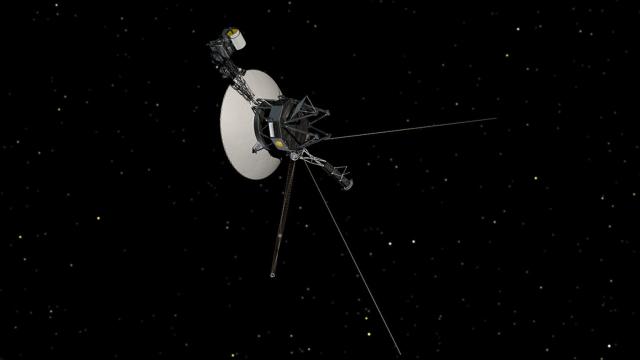NASA’s Voyager 2 spacecraft, currently 12.4 billion miles (19.9 billion kilometres) from Earth, has phoned home, essentially telling mission controllers that the recent rumours of its impending death have been greatly exaggerated. The ongoing communications problem, however, remains unresolved.
In a mission update tweeted earlier today, JPL announced that the Deep Space Network (DSN) snagged a carrier signal from Voyager 2, confirming that the 46-year-old spacecraft is in good health. NASA’s DSN consists of a worldwide network of large antennas and communication facilities that support interplanetary spacecraft, among other missions. Receipt of this “heartbeat” signal, as it’s also known, is a massive relief and a positive sign, but Voyager 2 is not yet out of the interstellar woods.
The problem started two weeks ago after NASA transmitted a potentially faulty command, causing Voyager 2’s antenna to point two degrees away from Earth. The probe is still transmitting data, but those signals are now bypassing Earth and are no longer being received. Consequently, “data being sent by the spacecraft is no longer reaching the DSN, and the spacecraft is not receiving commands from ground controllers,” according to NASA. Signals take approximately 18.5 hours to reach Voyager 2 at its present distance.
Suzanne Dodd, project manager at NASA’s Jet Propulsion Laboratory (JPL), said mission controllers will now attempt to reorient Voyager 2’s antenna such that it correctly points towards Earth, as she told ABC News. JPL controllers are planning to send these commands “several times,” Dodd added. Should these attempts fail, NASA will have to wait until October 15 for an autonomous system reset, which the probe does several times each year to keep its antenna in the correct position.
Launched by NASA on August 20, 1977, Voyager 2 explored the outer solar system planets in extraordinary detail. It’s famous for its grand tour of the four giant planets—Jupiter, Saturn, Uranus, and Neptune—providing invaluable data and images of their atmospheres, moons, and magnetospheres. Up until this latest communications issue, Voyager 2 continued to send data back to Earth as it ventured deeper into interstellar space, operating well beyond its original mission parameters.
Its twin, Voyager 1, launched into space on September 5, 1977, performing flybys of Jupiter and Saturn, and it remains the farthest human-made object from Earth, and it too is sending data back from interstellar space. Both probes are expected to remain operational for several more years, so hopefully NASA will get this sorted out such that these historic missions can continue.
For more spaceflight in your life, follow us on Twitter and bookmark Gizmodo’s dedicated Spaceflight page.
